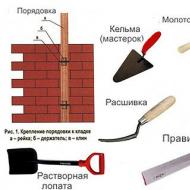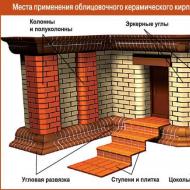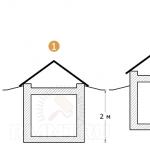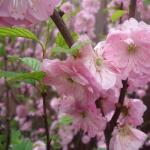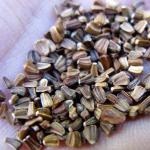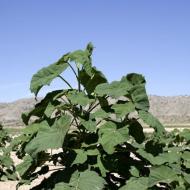
Paulownia wood properties. Paulownia Adam's tree: description
This plant is native to China. Paulownia or Adam's tree grows very quickly. It is valued for its light wood, from which furniture, shelving, pressed materials, plywood, and musical instruments are made.
Despite the fact that the tree is accustomed to a tropical climate, it can often be found in central Russia, where a temperate climate prevails. Paulownia is used mainly for decorating gardens, parks, squares. It impresses with its size.
Paulownia, although a deciduous tree, can grow up to 20 meters in height. But there are also individuals of 10-15 meters.
The crown of the Adam tree is lush and sprawling, has the shape of a ball or oval. The branches originate from a wide and strong trunk, the diameter of which reaches about half a meter, and sometimes this value can reach 80-90 cm.
The branches of the tree hang down to the ground. The branches and trunk are usually gray, with a brownish tinge, in color. The bark is quite smooth, it has longitudinal furrows.
Paulownia leaves are very large, heart-shaped, 30-40 cm long and 25-35 wide. Their color is rich green.

Due to the fact that the lower leaves resemble felt material, it is also called Felt Paulownia. Its huge leaves hang on long cuttings. The upper leaves, on the contrary, are soft and fluffy. The first leaves appear in late spring, so they fall late - before the first hard frosts.
The flowers of the tree bloom at the same time that the first leaves appear. Sometimes flowering begins before the leaves appear. Therefore, you can often find blooming Paulownia without leaves.
This unusual tree blooms profusely. Its flowers are purple, sometimes various shades are added to the main color: from light pink to darker blue. Often found - a blue tint.
The flowers are in the shape of an elongated large bell. The diameter of each bell is about 5-7 cm. Many of these flowers are collected in inflorescences that resemble a broom. Its dimensions are amazing: 35-40 cm in length.
During the flowering period, Paulownia exudes a pleasant delicate aroma. The flowering period begins in spring, and ends only in July, then seeds in boxes appear in place of the flowers. They ripen in October and remain to winter on the branches. The laying of color for the next spring begins immediately after the color disappears, in the summer.
Paulownia grows in China, Japan, Crimea, the Far East and Ukraine.

cultivation
Outdoors:
Paulownia is an ornamental and low maintenance tree. The only drawback of this tree is its low winter hardiness.
In the Krasnodar Territory and the Crimea, where the climate is warm, Paulownia quickly grows from a seedling into a luxurious sprawling tree. In areas with severe winters, its young branches die. But Paulownia can be grown even under such conditions, if it is well insulated (the plant easily leaves).
Paulownia prefers soil of any acidity: both slightly acidic and strongly alkaline. But the best option is medium-nutrient light soil or loam.
The tree feels great on the sunny side in a 1x1 m hole. You need to insert a support peg into the hole, and next to it is the plant itself. It must be tied to a peg, covered with soil and watered abundantly.
The first years of garden Paulownia require regular watering and pruning to give the desired shape to the crown. Feeding also plays a big role.
In room conditions:
The earth in the Paulownia pot should not be waterlogged, otherwise the formation of wood may be slow. Therefore, the plant should be watered moderately (up to 2 years, the plant is watered 2 times a month).
reproduction
Paulownia can be propagated in three ways:
In stores, Paulownia seeds are very rare. They have good germination only for the first 6 months, and then the ability to germinate is lost. Therefore, you should pay attention to the expiration date written on the package.
Sowing is done in early spring in a low container. The seeds are evenly laid out on a damp surface and lightly sprinkled with earth, covered with foil and placed in a warm, sunny place. Sprouts will appear in 28-35 days. When they have 1-2 pairs of good leaves, they should be divided into separate containers.

- cuttings.
- Root offspring.
Cuttings and root offspring from the tree are taken in spring or autumn. But the escape should not be too long. During planting, the cutting is inserted into the hole to the level of the soil or left 3-4 cm above the surface. Otherwise, the young trunk will bend. If the root starts several shoots, you need to leave the strongest, and remove the others with pruners.
Paulownia is responsive to fertilizers containing minerals throughout the growing season. Feeding should be stopped after the leaves begin to fall.
Adam tree care
The period of active growth of the Adam tree begins in mid-April and lasts 2 weeks. Care is:
- In timely weeding. This is especially important at the beginning of the growth of seedlings. It is forbidden to resort to chemicals in weed control, as the Adam tree is susceptible to poisons and may die.
- In hilling.
- In regular watering: 1-2 times a week.
- In feeding.
What to feed
In the first year of life, the tree is fed once a week with high-nitrogen fertilizers, dissolving them in water. Top dressing for an Adam tree will serve well as a layer of mulch laid out around the trunk. Mulch consists of:
- Seine;
- dry leaves;
- straw;
- compost;
- Peat.
In the water for watering the tree, you can add an infusion of weeds.
Diseases and pests
Paulownia is often affected by the blackleg. This occurs when violations of the temperature regime and irrigation, excessive humidity of air and soil. For prevention, it is recommended to treat the soil, seeds and seedlings with Baktofit and Fitosporin. The same fungicides will cure diseased plants.
Paulownia trees, especially weak and young ones, are attacked by scale insects and aphids. Modern insecticides will save Paulownia from these insects.
Many gardeners admire Paulownia, but note that it is very difficult to grow a tree from seeds, and if they succeed in doing this, then the seedlings will be weak and problematic. But propagation by cuttings is a very effective way to grow this beautiful tree in your country house.
Views: 74532
03.12.2018
(lat. Paulownia, the Paulownia family) or adam tree- perennial tall (up to 15 - 20 m in height) and fast-growing deciduous plant with very large leaves (from 20 cm to 50 cm) and beautiful fragrant inflorescences (up to 30 - 50 cm long) of pale purple (sometimes white) flowers. Distributed in North America, Europe and Asia as a valuable garden crop for regions with a warm and humid climate. And recently, with the search for alternative energy sources, it has gained great popularity as a quality. The growth rate of the tree is ahead of all woody plants existing in the world, and already at the age of 8 - 9 its wood reaches full maturity. Paulownia leaves are also unique in their chemical composition. They contain up to 20% of proteins (proteins), in taste they resemble the greens of alfalfa, clover, therefore they are a valuable feed in animal husbandry. Can also be used for salads. In addition, they are able to absorb 10 times more carbon dioxide than the leaves of ordinary trees.
The birthplace of the tree is China, where the plant is known under the name dragon tree and is widely used not only in traditional medicine, but also in pharmaceuticals. Extracts based on paulownia leaves improve the functioning of the liver, gallbladder, kidneys, and eliminate problems with the lungs. The seeds serve as a source for the production of industrial oil, and in ancient times they were used for the safe transportation of precious porcelain products. In Japan, the image of paulownia (leaves and flowers) can be seen on coins and in heraldry. This plant (Paulownia felt) has long been honored and cultivated as imperial tree. There are legends about him, Japanese folk customs and traditions are associated with him.

Since paulownia is characterized by unusually fast growth, and its wood has many valuable qualities (lightness; fire resistance due to the low content of resinous substances; high content of tannins, which serves as protection against insect damage; low humidity, not exceeding 10 - 12%, excellent insulating and acoustic indicators), the plant is in high demand in the production of furniture, plywood, aircraft and shipbuilding, in the manufacture of musical instruments, souvenirs, toys, sports equipment, wooden building structures (in traditional Japanese dwellings).

Another valuable quality of paulownia: due to its rapid growth and active development of the root system, plantings of this crop are able to prevent erosion in fertile soil horizons, restore areas of land affected by fires, landslides, mudflows and other natural destructions in the shortest possible time. A significant amount of its biomass, which enters the soil after leaf fall, enriches the soil with useful organic substances.

Paulownia is widely used for landscaping urban landscapes, in landscape gardening, to create recreation areas. Its large leaves, pubescent on both sides, create a magnificent shade and give coolness on a hot summer day. In addition, due to the large area of leaf plates, paulownia successfully purifies the air even in the most polluted and gassed areas, as well.

Incredibly beautiful tree and at the time of flowering, which occurs before the full blooming of the leaves, in late spring - early summer. Clusters of bluish-lilac (sometimes pale blue or white) inflorescences, consisting of large (up to 6 cm in diameter) bell-shaped flowers, exuding vanilla, with a slight almond flavor, attract honey insects. Paulownia honey resembles acacia honey in consistency and color and has very valuable medicinal properties. The culinary use of paulownia flowers as an exotic horn is interesting: in some European restaurants, flowers are filled with dessert to give the dish a special "delicious" aroma, sophistication and originality. Paulownia is also valued as an aromatic raw material in perfumery and cosmetology (manufacturing of perfumes, creams).

Although paulownia belongs to the cultures of the warm climatic zone, it is able to grow in mid-latitude conditions. Despite the low frost resistance (it can withstand short frosts down to -17 ° C), the tree is excellently restored by basal shoots. With age, the frost resistance of paulownia increases. In more severe conditions, it can be grown not as a tree, but as a perennial plant. The annual growth of paulownia is from 1.5 m or more. In addition, in the middle latitudes, its leaves reach larger sizes (up to 75 cm in diameter). The only drawback is that in a cold climate, paulownia does not have time to go through the flowering phase.

The culture propagates by seeds and vegetatively. Paulownia loves well-drained, neutral soils. Can grow in full sun and partial shade. Does not like strong winds (especially in the first years of development). Very unpretentious in care. The main difficulty is to prevent complete strong waterlogging of the soil or its drying. You can grow a crop in gardens, greenhouses, in tubs and even pots (as a houseplant).

In autumn, the ripened paulownia seeds spill out of their pods and are carried by the wind, so you need to collect them before this moment. For germination, the seeds are poured on top of a well-moistened nutrient mixture, sprayed with a spray bottle and covered with glass or film for 10-14 days. With the advent of seedlings, the glass (film) is removed daily for ventilation, first for a short time, and then gradually increasing this period. When the seedlings grow a little (usually after 10 days), they are seated in separate containers, trying not to damage the root system.

The vegetative method of growing paulownia (cuttings or root shoots) is the simplest. For its implementation, it is enough to separate the shoot from the donor plant (at the end of summer or autumn) and root it in a nutrient substrate. In spring, the plant is planted in a permanent habitat, observing the necessary condition: the upper cut of the cutting should not rise above ground level by more than 2–3 cm. When the shoots on the cutting grow to 10 cm, only one, the strongest, is left for further development, and the rest are removed.

The uniqueness of paulownia lies not only in the speed of its growth, but also in a whole range of useful qualities: valuable wood, nutritional qualities of leaves, aromatic properties of flowers, industrial use of seeds and vegetative part (as a raw material in bioenergy). In addition, growing paulownia is not particularly difficult even for beginner gardeners, and the beauty of a flowering tree will not leave anyone indifferent.
In this article I would like to touch on the topic of deforestation and talk about methods for solving this issue. As you know, trees such as oak, hornbeam, beech and others grow for a very long time and it takes more than one decade to get a mature tree ready for making boards. Intensive felling of trees and their slow growth at some point can lead to the problem of wood shortage, and people are already thinking about how to solve this issue. One solution might be to grow a paulownia, a plant that has been on everyone's lips lately. Its main advantage is its rapid growth.
In this article, we will talk about how to build a paulownia growing business, consider the important points of this line of business and indicate a whole list of risks that a novice entrepreneur may face.
Tree Description
Paulownia (lat. Paulównia), or as it is also called Adam's tree, is a fast-growing landscape tree that is usually grown in warm and humid climates. But due to the breeding of clones, it takes root well in our country, experiencing winter and drought.
Paulownias are deciduous tall trees with a straight trunk and spreading crown. The leaves are opposite, on long petioles, reaching a diameter of 40 cm. The leaf blade is large, deeply serrated or three-lobed. The leaf edge is complete. There are no stipules.
The flowers are large (up to 6 cm), purple-lilac, sometimes almost white, in paniculate inflorescences at the ends of the shoots. The calyx is bell-shaped.
Often this plant is grown in the urban area, and these are parks and squares. Firstly, they bloom beautifully (for 8 weeks), and secondly, they provide a comfortable shade. In addition, due to large leaves, one paulownia tree is able to absorb 22 kg of CO2 and produce up to 6 kg of oxygen, and this is a significant plus for the ecology of the city as a whole.

Basically, this tree is grown in Europe and East Asia, this tree came to us from Spain.
For 6 years, this tree grows 6 - 7 meters in height, it is cut off and a new sprout appears the next season. Thus, the plant can be reborn up to six times.
In our country, bred paulownia clones are most often used, one of the most popular is Paulownia Clone In Vitro 112 R, which is resistant to frost and pests.
So the tree can withstand negative temperatures up to -27 degrees Celsius, and heat up to +45 degrees Celsius. The only thing to consider is soil moisture.
The trunk diameter of a tree about 2 years old is up to 14 cm, a 3-4 year old tree is up to 20–24 cm, and an adult tree (up to 20 years old) reaches a trunk diameter of 100 cm.
Features of growing paulownia
Planting seedlings of this plant occurs in the spring. The pH level of the soil should be between 5 and 9. The paulownia trees themselves can be planted quite densely, for example, in a 4x4m pattern. Such a planting scheme will allow placing about 600 trees of this species per 1 ha of land.
The soil must be moist, so you need to organize watering plants every few days, or organize an automatic watering system, if you have the budget. Due to the massive root system, the tree absorbs moisture well from the ground.

After planting a seedling, the first year it grows and takes root, building up the root system. The next season (spring), the plant is cut at the root. They do this in order to start new sprouts, which will be more hardy. Subsequent cuts, when the tree is allowed for raw materials, occur after 6 to 7 years. If paulownia is grown for the manufacture of pellets, then the cut is made after 3 to 4 years.
If after winter the branches of the tree are frozen, it is necessary to cut them off.
Ways to monetize a palovnia plantation
There are several ways to monetize a paulownia plantation. They can all be used to diversify income and some of them do not interfere with each other.
Wood
The paulownia trunk is straight and resistant to bending. The wood has a beautiful structure with straight grains, it is clean, smooth (no knots), light and almost odorless. Its color changes from light yellow to light red.

Areas of wood use:
- in the carpentry.
- for making furniture.
- when building houses. It has a high compressive strength index of 281 kg/cm2. It lends itself well to processing with paints and varnishes for wood.
- for making musical instruments.
- small crafts for the home, such as cutting boards and others.
- toys.
- snowboards, skis and surfboards.
According to its characteristics, paulownia wood has high rates of heat and sound insulation.
honey production
The second profitable option for additional income in the fields of paulownia is the installation of an apiary near the landings. Due to the long flowering period of 8 weeks, up to 800 kg of delicious honey can be collected from 1 hectare of planted trees. Often, in appearance and taste, it is compared with acacia honey.
Another plus is the environmental friendliness of the product, because when growing paulownia you will not use chemistry. This can be a significant advantage in this business.
biofuel
Paulownia plantings are also called the concept of "intensive forest", because in a very short time, you can get ready-made wood for its subsequent processing. If you decide to sell biofuel in the form of pellets, then 3-4 years after planting a tree, you will already be able to cut it down and start processing it. Paulownia has high heat transfer rates. The energy value of paulownia pellets is 4211.1 kcal/kg. For example, 2 kg of pellets from this tree is equal to 1 liter of diesel fuel. This approach can begin to address the energy crisis.
Paulownia is also used to make bioethanol. About 0.5 tons of ethanol can be obtained from 1 ton of dried wood.
Sale of seedlings
Many farmers who try their hand at growing wood are actively interested in buying quality paulownia seedlings. You can maintain your website, show test sites where you plant your seedlings, and thus stimulate sales of seedlings for interested beginners.

Saplings are a seasonal income that can increase the profitability of your business.
Risks that may await start-up entrepreneurs
Beginners are waiting for a whole list of risks that may come their way. Let's deal with each of them so that you can save your money, and most importantly the time spent on this type of activity. All these nuances must be taken into account when developing a business plan for growing paulownia.
- Where to buy paulownia? This question is asked by every entrepreneur who decides to try to work with this tree. And here lies one of the mistakes - this is the purchase of seedlings from the first counter sellers on the market, especially there are a lot of them on ad sites. Their price is low, and the pictures are always beautiful, but you should always check a few points. Find out if these breeders have a website, or if you can visit their plantations in person to see everything in front of your eyes. After all, cases of posting other people's photos are not rare, or photos are taken in other people's fields. And in the end you will get a seedling of poor quality that will not bring any result.
- Is there a certificate? You will need documents for seedlings if you want to sell wood for import, besides, only one paulownia variety is officially registered in our country - this is Paulownia Clone In Vitro 112.
- Decorative or technical? Due to inexperience, you can acquire a decorative type of paulownia, which differs significantly in growth rate from a technical counterpart. So let's say, if a technical specimen of a plant grows in 5-8 years, then a decorative version takes 12-15 years. And this is a significant waste of time and money. In addition, technical wood has the best quality indicators.
- Can paulownia seeds be used? There are advertisements for the sale of seeds, but often such seeds do not overwinter, and the result will be zero. If we talk about clone trees, then they are generally sterile.
- Do I need to follow all the rules of disembarkation and departure? If you do not take care of the plants, water them, cut off the frosted parts of the tree, plant them in the sun, then the results will be very poor.
These are the main risks that beginners can face.
What about the prices?
The price tag for standard logs with a thickness of 35 - 45 cm and a length of up to 20 meters is about $ 100 - $ 120 per cubic meter.
Domestic carpentry workshops are already starting to work with this wood, which cannot but rejoice. You can look for intermediaries who sell wood abroad and arrange wholesale delivery for them.
Conclusions. Paulownia (aluminum tree) is a promising business project that has just begun to develop in our country. Due to the growth rate - 5 - 8 years, you get the finished material, and then the tree is reborn and begins to grow again, which ensures the service life of one seedling for 40 - 50 years. With proper care, 200-350 cubic meters of wood can be obtained from 1 hectare of land.
It's just such a miracle tree! Last night I accidentally found out about him and immediately lost sleep :) I ordered seeds. I will grow!
View of the fastest growing trees in the world
A 1-year-old tree reaches 5 meters in height.
A 2-year-old tree reaches 8-10 meters in height.
A 5-year-old tree reaches 15-17 meters in height.
The trunks are strong, smooth, without defects.
The tree can be cut down to a stump each spring.
The maximum height of an adult tree is 20-25 meters.
Wood is almost 4 times lighter than oak wood and half as light as pine wood.
The largest ratio between strength and mass among tree species.
The ability to resist deformation under load (MOR ratio) is 843 kg per square cm.
The size of the leaves of a young tree is about 75 cm in diameter (huge!)
After leaf fall, it provides quick fertilization of the affected area.
Leaves need a huge amount of carbon dioxide for growth, respectively, a huge amount of oxygen is released into the atmosphere during their photosynthesis.
The leaves act as dust collectors, and the accelerated metabolism that accompanies rapid growth makes paulownia a true oxygen factory.
The best assistant in the creation of windbreaks, restoration of burned forests, and as an anti-erosion plantation.
A real treasure for ecologists! The tree, with its rapidly developing root system, is exceptionally suitable for reforestation!

And yet, it is an excellent honey plant!
Paulownia honey is light, transparent, very light and fragrant; in color and consistency, it can only be compared with acacia honey. Likewise, it is of the highest quality. In addition to being a delicacy, it also serves as a medicine. Its properties are known to have a beneficial effect and help in the treatment of bronchitis and other diseases of the lungs and respiratory system, as well as improves the function of the gallbladder, liver and digestion in general. These qualities of paulownia honey are due to the biologically active substances found in its flowers, so that the flowers themselves are not edible. In addition to the Chinese experience in this regard, we can not miss the recent fashionable use of paulownia flowers in the form of horns with cream - it may sound like an exotic dessert, but it is already part of the menu of many European restaurants.

Paulownia leaves are suitable for the production of forage for herbivores - they contain approximately 20% proteins and their qualities are close to those of alfalfa. Availability and high yield ensure low cost for fattening - one of the most important indicators when choosing forage in industrial animal husbandry.

It has been established that they contain substances that have a beneficial effect on the functioning of the liver, kidneys and gallbladder, and also work well for problems with the lungs. In China, these properties have been known for a long time, even the pharmaceutical industry is engaged in the industrial production of medicines based on paulownia. The leaves also have other properties - their use in cosmetics in Asian countries is as old as their use in medicine, but for Europe this is a novelty; only in recent years have paulownia leaf extracts been incorporated into creams and perfumes.

Even the seeds of this wonderful plant have their uses: back in the 19th century, they were used to pack expensive, thin, Chinese porcelain during transportation.
Paulownia biomass is suitable both for ensiling (respectively for fattening animals) and for many other purposes, among which is its use as a raw material for alternative, renewable energy sources.


One of the most promising uses for paulownia is bioethanol derived from its cellulose. In addition to the numerous applications in which it is currently used, some scientists see it as the fuel of the future - easy production and application without environmental risks. There are two methods for obtaining bioethanol: the first is with the help of microorganisms cultivated for this purpose, using cellulose as an energy source and releasing ethanol as a result of metabolic processes; the second is based on the action of certain enzymes that decompose cellulose to the desired product. Although the second method is cheaper and more commonly used, both methods have a future and their advantages. As we have already explained, paulownia biomass is a suitable raw material for the production of bioethanol, but far from being the only one. After processing paulownia to obtain wood, branches and other parts naturally remain, which are formally called waste, but not only are they not thrown away, but they are another source of cellulose for bioethanol production. Thus, the cultivation and processing of paulownia is not only included in the natural way in the cycle of substances in nature, but also actively contributes to the ecological balance and conservation of the nature of our planet. From cellulose, plants also receive pellets, which have been sensational lately. They are used as a biofuel for pellet boilers that heat a single house or entire houses, and are also used for industrial purposes, as their use is constantly evolving. Easy and cheap biomass production is possible due to the following qualities of paulownia:
Does not require re-planting; even with low pruning, a new tree grows out of the hemp, which grows even faster, since the root system of the plant is sufficiently developed.
The trunk can be cut at any time, despite the season and there are no deadlines for harvesting.
Virtually nothing is lost from the paulownia tree; nothing pollutes or changes the environment. In this sense, without exaggeration, this tree can be called the “Tree of the Future”, because our earth has a future only when we treat our resources with intelligence and the necessary care.

One of the interesting qualities of the paulownia tree is the wonderful properties of its wood. The first of these is its versatility. Although it has been used for centuries, today we are amazed at the many ways this wood is used, including some that we are only learning about. Of course, the incentive to keep looking for new uses for wood is its low cost. After comparing the price with its qualities, it becomes clear that we are not far from the ideal wood.

The first impression made by paulownia wood is its incredible lightness. This is the reason for its preference in the manufacture of parts where low weight is critical, such as aircraft structures or parts of ships. It is also highly valued as a material for boxes, pallets and finished products for transportation, as it reduces the overall weight of the goods; this leads to a reduction in fuel consumption, an increase in the volume of transported products, and this in turn to a decrease in transportation prices, which is finally the main goal of logistics companies. Recently, this type of wood has been preferred in interior solutions in the manufacture of cars. What makes her suitable is a combination of her qualities, lightness is only one of them.

Another such quality is the low moisture content and low fire hazard of paulownia wood material. The water content in wood is about 10-12%, it is difficult to absorb water, as a result of which parts made from such wood do not deform, as we are usually used to seeing wooden parts exposed to moisture. The reason for this is its hard fibrous structure associated with the special structure of its cells. This is what makes paulownia preferred when choosing a material for steam rooms and furniture. Its qualities make it suitable for almost everything: for children's toys, for blinds, for parquets and, last but not least, for musical instruments. The material is distinguished by its acoustic properties, familiar to Asian masters. Recently, European musical instruments have also been made from paulownia wood, but this area has yet to develop.


There is almost no place in the atmosphere of the house where paulownia wood would not be desirable - except for blinds, lining and furniture, after facing with hardwood, beautiful parquet is made from it. Especially for lovers of applied arts, we declare that paulownia is a material that woodcarvers are happy to process precisely because of its softness, in combination with difficult ignition and lack of deformation, it is an ideal material for the most complex carvings. And not last on the list of qualities of this wood is its smoothness and lack of knots. Very interesting quality of paulownia beams, hold the screws at the very edge and do not split, look at the photos:

At home, in China, paulownia has become one of the national plants. However, today it can be found not only in East Asia, but also in Europe. The elegance of paulownia is combined with the high quality of the wood. For its attractive appearance and useful properties, in addition to the official name, the tree received several poetic names.
Alternative names for paulownia
The main name of paulownia (paulownia) acquired in honor of Anna Pavlovna - daughters of Emperor Paul 1 - from the botanist J. Zuccarini, who first described the tree after visiting the Land of the Rising Sun. But this is far from the only name of the plant.
Adam's tree - so called paulownia for its vitality, the ability to quickly recover from serious damage and unpretentiousness to external conditions.
Sapphire, imperial, dragon or princess tree - paulownia received these beautiful names in her homeland, where many stories and legends are associated with it. Love for a flowering plant is attributed to many royal people.
Appearance description
Paulownia is a honey plant. Its beautiful flowers attract insects. It is believed that light fragrant honey has healing properties and has a particularly beneficial effect on the respiratory tract.
Due to the significant content of proteins, the leaves of the adam tree are excellent as animal feed. The advantage in this case is also a high growth rate.




